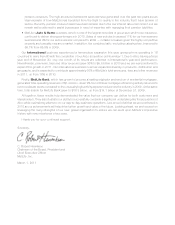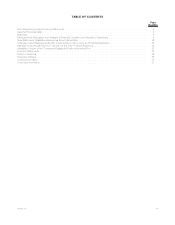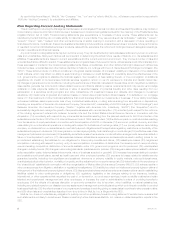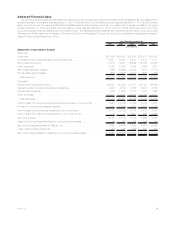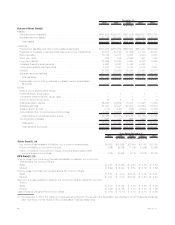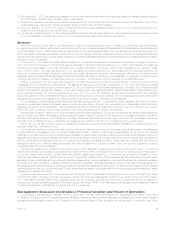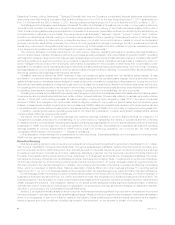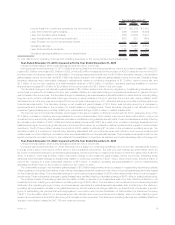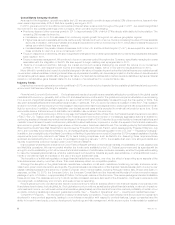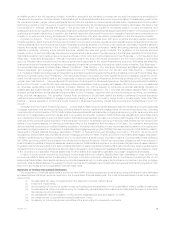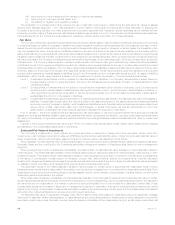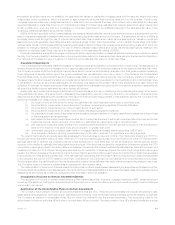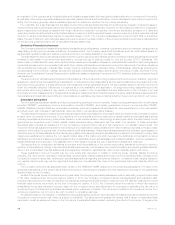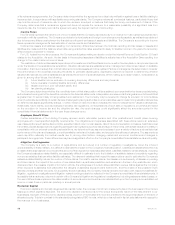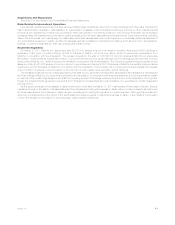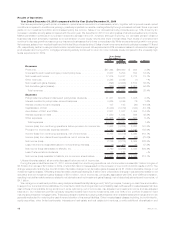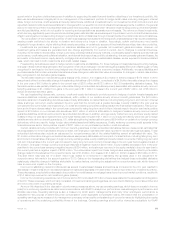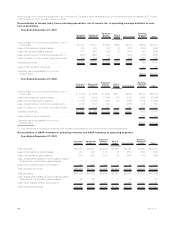MetLife 2010 Annual Report Download - page 13
Download and view the complete annual report
Please find page 13 of the 2010 MetLife annual report below. You can navigate through the pages in the report by either clicking on the pages listed below, or by using the keyword search tool below to find specific information within the annual report.(viii) accounting for income taxes and the valuation of deferred tax assets;
(ix) accounting for employee benefit plans; and
(x) the liability for litigation and regulatory matters.
The application of purchase accounting requires the use of estimation techniques in determining the estimated fair values of assets
acquired and liabilities assumed — the most significant of which relate to aforementioned critical accounting estimates. In applying the
Company’s accounting policies, we make subjective and complex judgments that frequently require estimates about matters that are
inherently uncertain. Many of these policies, estimates and related judgments are common in the insurance and financial services industries;
others are specific to the Company’s businesses and operations. Actual results could differ from these estimates.
Fair Value
The Company defines fair value as the price that would be received to sell an asset or paid to transfer a liability (an exit price) in the principal
or most advantageous market for the asset or liability in an orderly transaction between market participants on the measurement date. In many
cases, the exit price and the transaction (or entry) price will be the same at initial recognition. However, in certain cases, the transaction price
may not represent fair value. The fair value of a liability is based on the amount that would be paid to transfer a liability to a third party with the
same credit standing. It requires that fair value be a market-based measurement in which the fair value is determined based on a hypothetical
transaction at the measurement date, considered from the perspective of a market participant. When quoted prices are not used to determine
fairvalueofanasset,theCompanyconsidersthreebroadvaluationtechniques: (i) the market approach, (ii) the income approach, and (iii) the
cost approach. The Company determines the most appropriate valuation technique to use, given what is being measured and the availability
of sufficient inputs. The Company prioritizes the inputs to fair valuation techniques and allows for the use of unobservable inputs to the extent
that observable inputs are not available. The Company categorizes its assets and liabilities measured at estimated fair value into a three-level
hierarchy, based on the priority of the inputs to the respective valuation technique. The fair value hierarchy gives the highest priority to quoted
prices in active markets for identical assets or liabilities (Level 1) and the lowest priority to unobservable inputs (Level 3). An asset or liability’s
classification within the fair value hierarchy is based on the lowest level of input to its valuation. The input levels are as follows:
Level 1 Unadjusted quoted prices in active markets for identical assets or liabilities. The Company defines active markets based on
average trading volume for equity securities. The size of the bid/ask spread is used as an indicator of market activity for fixed
maturity securities.
Level 2 Quoted prices in markets that are not active or inputs that are observable either directly or indirectly. Level 2 inputs include
quoted prices for similar assets or liabilities other than quoted prices in Level 1; quoted prices in markets that are not active; or
other significant inputs that are observable or can be derived principally from or corroborated by observable market data for
substantially the full term of the assets or liabilities.
Level 3 Unobservable inputs that are supported by little or no market activity and are significant to the estimated fair value of the assets or
liabilities. Unobservable inputs reflect the reporting entity’s own assumptions about the assumptions that market participants
would use in pricing the asset or liability. Level 3 assets and liabilities include financial instruments whose values are determined
using pricing models, discounted cash flow methodologies, or similar techniques, as well as instruments for which the
determination of estimated fair value requires significant management judgment or estimation.
Prior to January 1, 2009, the measurement and disclosures of fair value based on exit price excluded certain items such as nonfinancial
assets and nonfinancial liabilities initially measured at estimated fair value in a business combination, reporting units measured at estimated
fair value in the first step of a goodwill impairment test and indefinite-lived intangible assets measured at estimated fair value for impairment
assessment.
In addition, the Company elected the fair value option (“FVO”) for certain of its financial instruments to better match measurement of assets
and liabilities in the consolidated statements of operations.
Estimated Fair Value of Investments
The Company’s investments in fixed maturity and equity securities, investments in trading and other securities, certain short-term
investments, most mortgage loans held-for-sale, and MSRs are reported at their estimated fair value. In determining the estimated fair value of
these investments, various methodologies, assumptions and inputs are utilized, as described further below.
When available, the estimated fair value of securities is based on quoted prices in active markets that are readily and regularly obtainable.
Generally, these are the most liquid of the Company’s securities holdings and valuation of these securities does not involve management
judgment.
When quoted prices in active markets are not available, the determination of estimated fair value is based on market standard valuation
methodologies. The market standard valuation methodologies utilized include: discounted cash flow methodologies, matrix pricing or other
similar techniques. The inputs to these market standard valuation methodologies include, but are not limited to: interest rates, credit standing
of the issuer or counterparty, industry sector of the issuer, coupon rate, call provisions, sinking fund requirements, maturity, estimated
duration and management’s assumptions regarding liquidity and estimated future cash flows. Accordingly, the estimated fair values are based
on available market information and management’s judgments about financial instruments.
The significant inputs to the market standard valuation methodologies for certain types of securities with reasonable levels of price
transparency are inputs that are observable in the market or can be derived principally from or corroborated by observable market data. Such
observable inputs include benchmarking prices for similar assets in active, liquid markets, quoted prices in markets that are not active and
observable yields and spreads in the market.
When observable inputs are not available, the market standard valuation methodologies for determining the estimated fair value of certain
types of securities that trade infrequently, and therefore have little or no price transparency, rely on inputs that are significant to the estimated
fair value that are not observable in the market or cannot be derived principally from or corroborated by observable market data. These
unobservable inputs can be based in large part on management judgment or estimation, and cannot be supported by reference to market
activity. Even though unobservable, these inputs are based on assumptions deemed appropriate given the circumstances and consistent
with what other market participants would use when pricing such securities.
The estimated fair value of residential mortgage loans held-for-sale is determined based on observable pricing of residential mortgage
loans held-for-sale with similar characteristics, or observable pricing for securities backed by similar types of loans, adjusted to convert the
securities prices to loan prices. Generally, quoted market prices are not available. When observable pricing for similar loans or securities that
10 MetLife, Inc.


